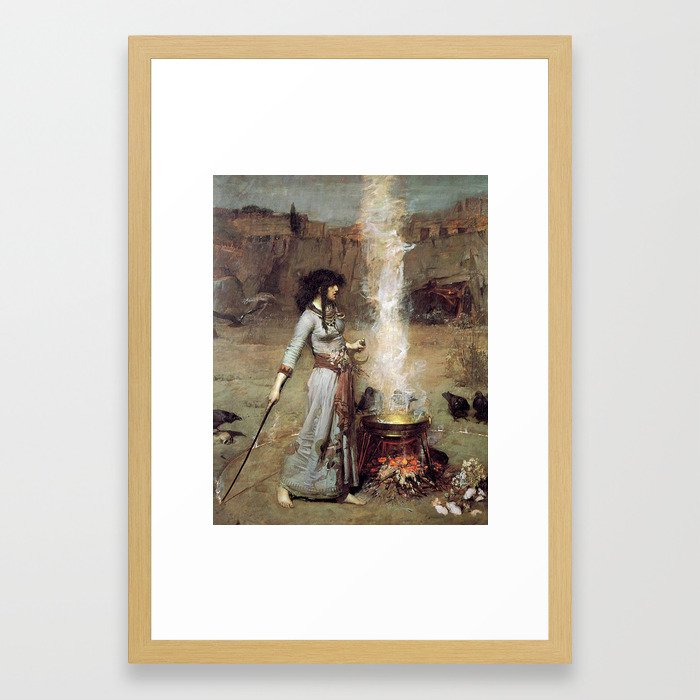
The timestamp is only as accurate as the clock in the camera, and it may be completely wrong. If the file has been modified from its original state, some details such as the timestamp may not fully reflect those of the original file. Buy Art Print Art Print Buy Stretched Canvas Print.
#THE MAGIC CIRCLE WATERHOUSE PAINTING SOFTWARE#
When the picture was exhibited at the Royal Academy in 1886 the critic for the Magazine of Art wrote 'Mr Waterhouse, in The Magic Circle, is still at his best – original in conception and pictorial in his results' (quoted in Hobson, p.This file contains additional information such as Exif metadata which may have been added by the digital camera, scanner, or software program used to create or digitize it. The logo on the image will not appear on the final art painting. The meaning of the picture is unclear, but its mystery and exoticism struck a chord with contemporary observers. Browse thousands of oil paintings like this in our library and commission top quality reproductions. But within its confines are flowers and the woman herself, objects of beauty. Outside the circle the landscape is bare and barren a group of rooks or ravens and a frog – all symbols of evil and associated with witchcraft – are excluded. The Magic Circle posters, canvas prints, framed pictures, postcards & more by John William Waterhouse. With the wand in her right hand she draws a protective magic circle round her. In her left hand she holds a crescent-shaped sickle, linking her with the moon and Hecate. Her dress and general appearance is highly eclectic, and is derived from several sources: she has the swarthy complexion of a woman of middle-eastern origin her hairstyle is like that of an early Anglo-Saxon her dress is decorated with Persian or Greek warriors. The woman in this picture appears to be a witch or priestess, endowed with magic powers, possibly the power of prophecy. This is one of Waterhouse's earlier works, and reflects his fascination with the exotic. His oeuvre also includes a number of middle-eastern subjects, in which he drew on the work of contemporary artists such as J.F Lewis (1805–76) and Lawrence Alma-Tadema (1836–1912), rather than on actual experience. More specifically, the notion of woman as enchantress is one that recurs in images such as Circe Offering the Cup to Ulysees (1891, Oldham Art Gallery) and Hylas and the Nymphs (1896, Manchester City Art Gallery). Miracles, magic and the power of prophecy are common themes in Waterhouse's art.

Unlike Frederick Sandys' portrayals of sorceresses, such as his Medea (1868) or Morgan le Fay (1864), Waterhouse chose to make his witch's face intent and intriguing, as opposed to malevolent. If John William Waterhouse The Magic Circle is printed by machine on textured canvas, it takes about 5 working days to your address if you choose it as. The witch wears a similar dress to Miranda and her face can also only be seen in profile. The Magic Circle is similar in composition to Waterhouse's later picture, Miranda (1916), also a woman associated with magic. A live snake ouroboros loops around the woman's neck. It is now displayed in the collection of Lord Lloyd-Webber. Instead of billowing outwards or being affected by the wind, it remains in a straight line. The witch's power is emphasised by the determined face, by her exclusion of the ravens and frog – popular symbols representing magic – and by her command over the smoke pillar. Waterhouse paid careful attention to the angles employed in this work, balancing the circle the figure is drawing around herself by the use of a triangle – her straight arm, extended by the straight stick, held out at 25 degrees to her erect body. The surrounding landscape is hazy, as though it is not quite real, and the background figures are only discernible on close inspection, deliberately ensuring the witch is the only image of importance. In a style typical of Waterhouse, the main character is a lone, female figure, placed centrally on the canvas.

Artist: John William Waterhouse 160.00 480. The painting was extremely successful with the critics and public alike. The Magic Circle (John William Waterhouse) The Magic Circle The Magic Circle This painting is also in high demand from art lovers around the world which can be purchased at a substantially fraction of the cost through JBenArts. The painting was well received at its exhibition, and was purchased for £650 the same year by the Tate Gallery, through the Chantrey Bequest. Journal: The Magic Circle - John William Waterhouse Classic Victorian Paintings Prosper, Victoria on. The image is in the Public Domain, and tagged Witches, Magic and Ritual & Ceremony. Eulalia, was Waterhouse's third exhibit with a supernatural theme in as many years. The Magic Circle is a Pre Raphaelite Oil on Canvas Painting created by John William Waterhouse in 1886. The Magic Circle was shown at the Royal Academy in 1886, and, after Consulting the Oracle and St.


 0 kommentar(er)
0 kommentar(er)
